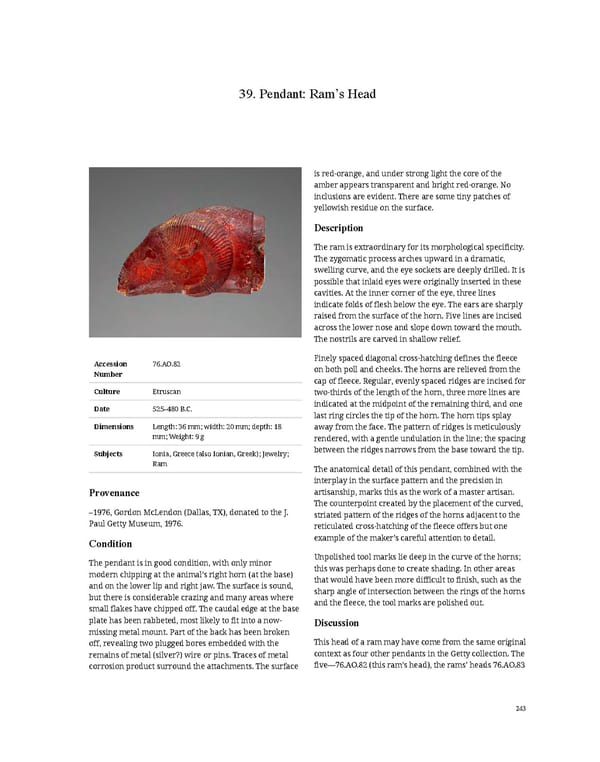39. Pendant: Ram’s Head is red-orange, and under strong light the core of the amber appears transparent and bright red-orange. No inclusions are evident. There are some tiny patches of yellowish residue on the surface. Description The ram is extraordinary for its morphological specificity. The zygomatic process arches upward in a dramatic, swelling curve, and the eye sockets are deeply drilled. It is possible that inlaid eyes were originally inserted in these cavities. At the inner corner of the eye, three lines indicate folds of flesh below the eye. The ears are sharply raised from the surface of the horn. Five lines are incised across the lower nose and slope down toward the mouth. The nostrils are carved in shallow relief. Accession 76.AO.82 Finely spaced diagonal cross-hatching defines the fleece Number on both poll and cheeks. The horns are relieved from the cap of fleece. Regular, evenly spaced ridges are incised for Culture Etruscan two-thirds of the length of the horn, three more lines are Date 525–480 B.C. indicated at the midpoint of the remaining third, and one last ring circles the tip of the horn. The horn tips splay Dimensions Length: 36 mm; width: 20 mm; depth: 18 away from the face. The pattern of ridges is meticulously mm; Weight: 9 g rendered, with a gentle undulation in the line; the spacing Subjects Ionia, Greece (also Ionian, Greek); Jewelry; between the ridges narrows from the base toward the tip. Ram The anatomical detail of this pendant, combined with the interplay in the surface pattern and the precision in Provenance artisanship, marks this as the work of a master artisan. The counterpoint created by the placement of the curved, –1976, Gordon McLendon (Dallas, TX), donated to the J. striated pattern of the ridges of the horns adjacent to the Paul Getty Museum, 1976. reticulated cross-hatching of the fleece offers but one Condition example of the maker’s careful attention to detail. The pendant is in good condition, with only minor Unpolished tool marks lie deep in the curve of the horns; modern chipping at the animal’s right horn (at the base) this was perhaps done to create shading. In other areas and on the lower lip and right jaw. The surface is sound, that would have been more difficult to finish, such as the but there is considerable crazing and many areas where sharp angle of intersection between the rings of the horns small flakes have chipped off. The caudal edge at the base and the fleece, the tool marks are polished out. plate has been rabbeted, most likely to fit into a now- Discussion missing metal mount. Part of the back has been broken off, revealing two plugged bores embedded with the This head of a ram may have come from the same original remains of metal (silver?) wire or pins. Traces of metal context as four other pendants in the Getty collection. The corrosion product surround the attachments. The surface five—76.AO.82 (this ram’s head), the rams’ heads 76.AO.83 243
 Ancient Carved Ambers in the J. Paul Getty Museum Page 252 Page 254
Ancient Carved Ambers in the J. Paul Getty Museum Page 252 Page 254